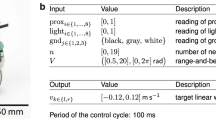Abstract
We investigate the reality gap, specifically the environmental correspondence of an on-board simulator. We describe a novel distributed co-evolutionary approach to improve the transference of controllers that co-evolve with an on-board simulator. A novelty of our approach is the the potential to improve transference between simulation and reality without an explicit measurement between the two domains. We hypothesise that a variation of on-board simulator environment models across many robots can be competitively exploited by comparison of the real controller fitness of many robots. We hypothesise that the real controller fitness values across many robots can be taken as indicative of the varied fitness in environmental correspondence of on-board simulators, and used to inform the distributed evolution an on-board simulator environment model without explicit measurement of the real environment. Our results demonstrate that our approach creates an adaptive relationship between the on-board simulator environment model, the real world behaviour of the robots, and the state of the real environment. The results indicate that our approach is sensitive to whether the real behavioural performance of the robot is informative on the state real environment.










Similar content being viewed by others
Explore related subjects
Discover the latest articles, news and stories from top researchers in related subjects.References
Bjerknes J, Winfield A (2013) On fault tolerance and scalability of swarm robotic systems. In: Martinoli A, Mondada F, Correll N, Mermoud G, Egerstedt M, Hsieh MA, Parker LE, Sty K (eds) Distributed autonomous robotic systems, Springer tracts in advanced robotics, vol 83. Springer, Berlin, pp 431–444
Bongard J, Zykov V, Lipson H (2006) Resilient machines through continuous self-modeling. Science 314:1118–1121
Eiben AE, Haasdijk E, Bredeche N (2010) Embodied, on-line, on-board evolution for autonomous robotics. In: Levi P, Kernbach S (eds) Symbiotic multi-robot organisms. Springer, Berlin, pp 367–388
Eiben A, Karafotias G, Haasdijk E (2010) Self-adaptive mutation in on- line, on-board evolutionary robotics. In: Proceedings of the Workshop on Self-Organisation in Pervasive Adaptive Systems (PerAda) at the Fourth IEEE International Conference on Self-Adaptive and Self-Organizing Systems (SASO 2010). IEEE Press, Piscataway
Haasdijk E, Eiben A, Karafotias G (2010) On-line evolution of robot controllers by an encapsulated evolution strategy. In: Proceedings of the 2010 IEEE Congress on Evolutionary Computation, Barcelona, Spain, 2010b. IEEE Computational Intelligence Society, IEEE Press
Hayes A, Martinoli A, Goodman R (2003) Swarm robotic odor localization: off-line optimization and validation with real robots. Robotica 21(4):427–441
Jakobi N, Husbands P, Harvey I (1995) Noise and the reality gap: the use of simulation in evolutionary robotics. In: Advances in Artificial Life: Proceedings of 3rd European Conference on Artificial Life, Springer, pp 704–720
Kernbach S, Meister E, Scholz O, Humza R, Liedke J, Ricotti L, Jemai J, Havlik J, Liu, W (2009) Evolutionary robotics: the next-generation-platform for on-line and on-board artificial evolution. In: Evolutionary Computation, 2009. CEC ’09. IEEE Congress on, pp 1079–1086
Koos S, Mouret JB, Doncieux S (2013) The transferability approach: crossing the reality gap in evolutionary robotics. IEEE Trans Evol Comput 17(1):122–145
Knig L, Jebens K, Kernbach S, Levi P (2008) Stability of on-line and on-board evolving of adaptive collective behavior. In: Bruyninckx H, Preucil L, Kulich M (eds) European robotics symposium 2008, Springer tracts in advanced robotics, vol 44. Springer, Berlin, pp 293–302
Liu W, Winfield A (2011) Open-hardware e-puck linux extension board for experimental swarm robotics research. Microprocess Microsyst 35(1):60–67
Liu W, Winfield AF (2009) A macroscopic probabilistic model of adaptive foraging in swarm robotics systems. In: 6th Vienna International Conference on Mathematical Modelling, Vienna, pp 11–13
Mataric M, Cliff D (1996) Challenges in evolving controllers for physical robots. Rob Auton Syst 19(1):67–83
Miglino O, Lund H, Nolfi S (1996) Evolving mobile robots in simulated and real environments. Artif Life 2:417–434
Mondada F, Bonani M, Raemy X, Pugh J, Cianci C, Klaptocz A, Magnenat S, Zufferey J, Floreano D, Martinoli A (2009) The e-puck, a robot designed for education in engineering. In: Proceedings of the 9th Conference on Autonomous Robot Systems and Competitions, pp 59–65
Nolfi S, Parisi D (1995) Evolving non-trivial behaviors on real robots: an autonomous robot that picks up objects. In: Gori M, Soda G (eds) Topics in artificial intelligence, vol 992., Lecture Notes in Computer ScienceSpringer, Berlin, pp 243–254
Nolfi S, Parisi D (1997) Learning to adapt to changing environments in evolving neural networks. Adapt Behav 5(1):75–98
O’Dowd P, Winfield A, Studley M (2010) Towards accelerated distributed evolution for adaptive behaviours in swarm robotics. In: Proceedings of Towards Autonomous Robotic Systems (TAROS 2010), pp 169–175
Schlachter F, Schwarzer C, Kernbach S, Michiels N, Levi P (2010) Incremental online evolution and adaptation of neural networks for robot control in dynamic environments. In: Adaptive 2010, the second international conference on adaptive and self-adaptive systems and applications, pp 111–116
Schut M, Haasdijk E, Eiben A (2009) What is situated evolution? In: Evolutionary Computation, 2009. CEC ’09. IEEE Congress on, pp 3277–3284
Seeley TD (2002) When is self-organization used in biological systems? Biol Bull 202(3):314–318
Tomassini M (2005) Spatially structured evolutionary algorithms: artificial evolution in space and time (natural computing series). Springer, Secaucus
Trianni V (2006) On the evolution of self-organising behaviours in a swarm of autonomous robots
Watson RA, Ficici SG, Pollack JB (2002) Embodied evolution: distributing an evolutionary algorithm in a population of robots. Rob Auton Syst 39(1):1–18
Zagal JC, Ruiz-Del-Solar J (2007) Combining simulation and reality in evolutionary robotics. J Intell Rob Syst 50(1):19–39
Author information
Authors and Affiliations
Corresponding author
Rights and permissions
About this article
Cite this article
O’Dowd, P.J., Studley, M. & Winfield, A.F.T. The distributed co-evolution of an on-board simulator and controller for swarm robot behaviours. Evol. Intel. 7, 95–106 (2014). https://doi.org/10.1007/s12065-014-0112-8
Received:
Revised:
Accepted:
Published:
Issue Date:
DOI: https://doi.org/10.1007/s12065-014-0112-8




